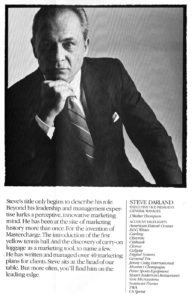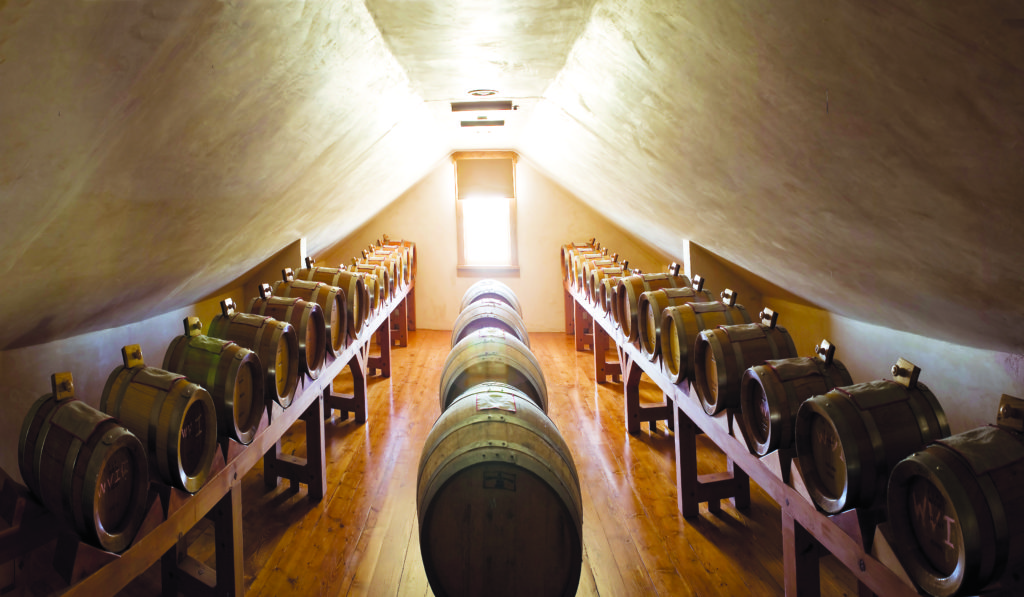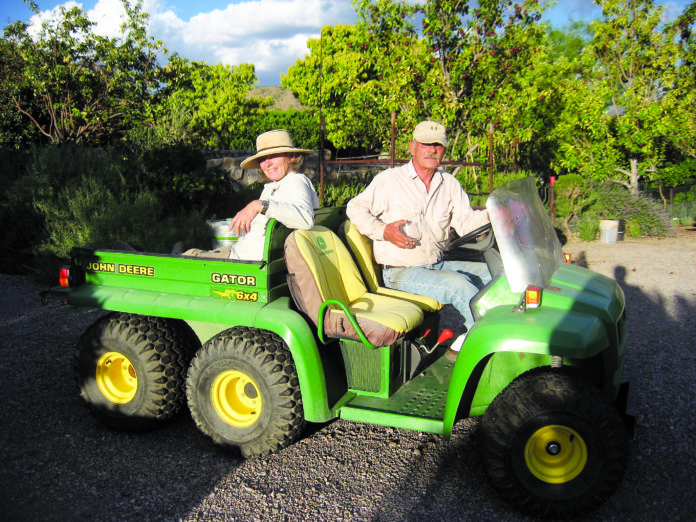Jane and Steve on their mile-high organic farm in Monticello, NM.
By Steve Darland
Note To Reader: A few months ago, Larry Coffman asked me to explain how I got from an advertising and marketing career to making traditional balsamic vinegar. Larry and I have known each other for about 40 years—first, when he was my client for the launch of Metro Transit. I formed an ad hoc agency, The Consortium, as a talented confederation of marketing people working out of their own service companies on assignments for non-profit organizations. Metro had a strong launch and we collectively built transit’s brand and ridership to record levels.
Just as I was beginning to jot my thoughts for this article, an email from Larry’s daughter, Melissa, inquired whether making balsamic is a hobby for me—and that reoriented my reply to her, to Larry and in this to you…
Classic Tradition
In brief, business success in the advertising world made huge demands within all parts of my life. My time increasingly was oversold and I was stressed. Despite the rewards, I concluded that my work life was not a smart trade for the life toll. The situation was not desperate, but it was not sustainable.
Seeking a change resulted in key conclusions: Change life, go rural, start a small organic farm, make something unique on a small, artisanal scale, fit life to a more natural human scale and pace. Finding those ideas and putting them to work took several years.
“…I soon clearly and repeatedly learned that all brands fade, then they die.”
Marketing tools helped cut through the clutter. As we learned what balsamic vinegar really was, where and how it originated—we realized how rare and delicious is the traditional original. We also learned that there was zero commercial production in the U.S. The near absence of competition tempts all marketing instincts, so we went forward.
In my last advertising work, my corporate role at J. Walter Thompson (JWT) was to build brands for a world of big clients. But I soon clearly and repeatedly learned that all brands fade, then they die. Companies undergo major change, get bought and/or almost always disappear. There are exceptions, but very few within any 100-year period of American business history.
So, what lasts? The answer is tradition. Think about it.
Traditional balsamic dates back at least 1,000 years. It is still handmade in very small amounts, though in a post-industrial and digital age. True balsamic is not brand or company dependent. It is always small scale. It belongs to and results from the artisan, and not corporate collaboration.
It is a true delicious classic, radically more nuanced than most other fancy foods. It is among the most rare and unique of luxury items. And the making of traditional balsamic will continue to endure, as it has for the last 10 centuries.
I sought to do a real thing like this. By hand. With my hands.

After graduating from the UW School of Communications in the late ’60s, I headed for NYC, first to work at the venerable JWT in account management—at the tail end of the Mad Men era. Other jobs—like working at the cool Mary Wells agency and in politics in D.C.—preceded my return to the Seattle marketing world, after seven years away.
Back in my hometown of Seattle, I focused my work first on marketing for non-profit organizations and creative communications projects, with new friends and talented associates—for another seven years—before JWT rehired me to run JWT/West out of San Francisco.
We tripled the billings to more than $300 million+ with great work and happy people, plus founding work on some of the world’s first websites for the dawning “Internet machine.” Our profit growth, work quality and happy clients got me promoted to the U.S. board of directors, then the world board of JWT.
Next, I was made an EVP and put on the 10-person Executive Committee, those who actually run the 217-office behemoth. My special, added portfolio: Worldwide brand director building global brands for our hefty client list (Ford, Nestlé, Kodak, Kraft, DeBeers, Rolex, etc.).
So, our performance was a role model at JWT, and I got busy visiting other offices and account groups around the world to share what we knew. I almost always was on an airplane. Plus, I still had a big agency to manage in the West, including some big-spending clients who had big needs and, ahem, expectations of regular, overt attention.
Airplanes, cars with drivers and fancy hotel rooms were a big part of the increasing blur of my life. My wife and partner, Jane, our two special children, Amy and Garrett, our magazine-perfect Marin home across the Golden Gate, even my waterfront Embarcadero One officers were each wonderful—yet each was a fading presence in my life.
Clearly, I needed a change, to slow down, to refocus.
The Bay area, then as now, was Foodieville. Everyone we knew had some impressive food connection: chefs, wine geeks and makers, grape producers, olive and olive oil producers and so on. These were our friends. Easily, I became an Epicurean in the sense that Epicurus was one, as was Thomas Jefferson (also of a Monticello, his in Virginia) in his notably Epicurean phrase: “Pursuit of Happiness.”
Jane and I decided we would start a new life chapter on an organic farm. California was too big, busy and expensive. New Mexico traced family trails and, though spatially huge, it has fewer than two million total citizens. Now, in our historic adobe town of Monticello, we have fewer than 50 neighbors and we’re just an hour from where 1,300 acres of grapes were being grown by Europeans, including for sparkling Gruet wine.
The original Spanish brought grapes here, and wild grapes climb the stone walls of our upper canyon. So, we knew from all this that we could grow grapes and make wine. But wine coming into the U.S. then, especially from the southern hemisphere, was bountiful and low-priced—some very good.
As a marketing person, I knew this suggested we aim elsewhere. And, among other things, we explored the possibilities of making true balsamic vinegar, the ultimate added value crop-to-product, even if slow.
We visited Northern Italy with our good friend chef Paul Bertolli, and toured the vinegar lofts (acetaie) of Modena, then spent time with the famous balsamic-cask maker, Francesco Renzi, whose family has exceeded 600 years in the same business, balsamic-cask making, in the same building!
Americans have awakened to balsamic vinegar relatively recently. And most people think they know what it is. Few do.

About 99.9% of balsamic sold in the states is what the Italians call “industrial balsamic.” It’s made in a flash, using a blend of red wine vinegar and a variety of dark, thick sweeteners, such as caramel, molasses or mosto cotto (fancy-sounding Italian words for cooked grape juice). Millions of bottles of this are shipped each year, largely to the U.S. (To those who think they like this, I recommend buying quality red wine vinegar for excellent, unsweetened dining results.)
Northern Italians have a raft of rules for making the real stuff. They call it traditional balsamic (Aceto Balsamico Tradizionale). It must be aged at least 12 years. it must be made of a single ingredient of specific grapes’ juices. It must be cask-aged. (We have all seven rare woods in our batteries of casks: oak, ash, acacia, cherry, juniper, chestnut and mulberry.) The real and ancient balsamic process is a secret, which we came to learn and practice.
Only 2,000 gallons/year are made in the world. This amount is produced by just 67 commercial makers. We are one of those, and the only one in the U.S. We are fairly certain we are the only organic maker of traditional balsamic in the world.
The only other real balsamic, according to the Italians, is also of a single ingredient, cask-aged, but less than 12 years old. It is named condiment balsamic. We make both traditional and condiment balsamic.
So, follow the grape: I pruned and picked Concords off of our garage when I was a kid growing up south of Seattle—and my Mom made jelly. My first NYC client in 1967 was the primary importer of European wines to the U.S. Returning to Seattle, I worked out of our marketing consultancy (Concept Management, Inc.) on assignments for Washington’s toddler wine industry. In the Bay area, JWT had numerous wine clients. Now, I have 1,200+ balsamic wine grapevines growing on our 50-acre organic farm—and like the Concord grapes—I’m the only one who prunes them.
We ordered casks—with a several-year wait time. We ordered balsamic vines grafted by an Italian-born wine producer near us, which when ready, we planted the next year—with a further three-year wait for plant maturity. We built a two-story acetaia (vinegar loft) where downstairs, below the cask room, we also store all the grape- and juice-handling equipment. We renovated an historic store to become our commercial kitchen and licensed bottling facility.
Once we made our first batch, we had only 12 years to wait—with a new crop and batch each year, every year, yet with no product output or income until a dozen years had expired (In 2017, our balsamic has aged for 20 years.)
In the meantime, we built the rest of our life around organic farming—of what we wanted to eat and what we could sell. We have more than 500 fruit and nut trees, acres of lavender and many other medicinal and culinary herbs we sell fresh, dried and distilled. We grow a large variety of rare, delicious vegetables in relatively modest quantities—for our table, for our neighbors and for the market.
We helped start the Farmers’ Market in nearby Truth or Consequences, NM. We and others pioneered the recycling program from nothing to a big, staffed, professional operation. We also helped form the T or C community kitchen and, separately, the community garden and a slew of other programs needed there.
Monticello was described as a “ghost town” before we arrived, and we helped bring it back to life, refurbishing more than a dozen historic adobes—and attracting others to join us.
So, if life is divided into Play, Work and Hobbies (plus Metaphysics and Family), I ask, which is which among the things we have done? As life unreels, these categories overlap, then merge into one.
My actual hobbies are global and cultural travel, family genealogy, all outdoor growing, fireworks, reading history, fly-fishing and salmon fishing (mostly in the southern hemisphere). I gave up drinking as a hobby, even though I was making wine, grappa, brandy and various liqueurs. I gave up smoking nicotine as a hobby, even though I was growing and curing tobacco for hand-rolling my small cigars.
Hobbies come and go. As I think of them, they quite often have to do with collecting things. In my case, I had to learn what to give up. And, then, to find what would be my life’s new focus. Rather than just biding time.
Now, educating info-starved Americans about this historic, odd, traditional and rare food—and exposing peoples’ minds and palates to true balsamic. This is an enjoyable, if tricky, junction, where my past and my present skills regularly meet.
This copyright© article was written by one of the original inductees into the pantheon of MARKETING IMMORTALS. In his new career, Steve sells his balsamic vinegar in selected high-end retailers and to quality restaurants, like Café Juanita—as well as online at organicbalsamic.com. Sales grow steadily each year, according to Steve. You can contact him at steve.darland@gmail.com.






